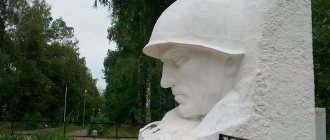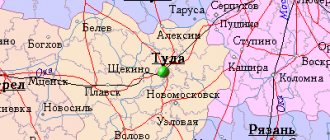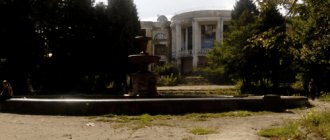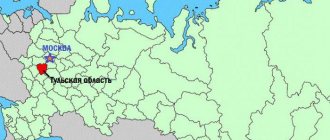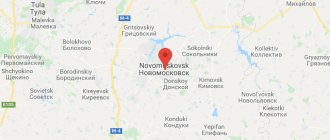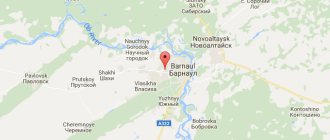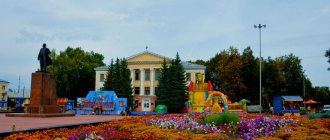“The Source of the Don” is an architectural complex created in the area where the Don River originates. There is a stone installed in the park, from under which a small artificial stream flows. This boulder is the conventional place where the great Don River originates. The natural and architectural complex “Istok Dona” has today become one of the local attractions that attracts tourists and city residents.
Complex "Istok Don" on Yandex.Maps panoramas
History of the Istok Don complex
The architectural complex was built on the territory of the Children's Park for a reason. The Urvanka stream flows in this area, which is actually mistaken for the source of the Don River. This is where the name of the natural-architectural complex “Source of the Don” came from.
For a long time, the territory within which the source of the Don is located was not properly developed. Only almost 60 years after the founding of Novomoskovsk, the question arose about organizing a park area at the site where the source is located.
Work on the construction of the architectural and park complex began in the second half of 1989. The grand opening of the “Source of the Don” took place in 2000 and was conventionally timed to coincide with the 70th anniversary of the founding of Novomoskovsk.
© sonicoff
Details
Historical reference
The history of the city of Novomoskovsk dates back to 1765. At that time, the village of Bobriki was located on this site, which was the property of Catherine II.
Bobriki received city status in 1930 and was part of the Uzlovsky district of the Moscow region. In 1933, the beavers were renamed Stalinogorsk.
During the Great Patriotic War, the city was occupied for 17 days - November 25-December 12, 1941. An underground organization and partisan detachments operated in Stalinogorsk. Almost 8,000 townspeople died during the war.
In 1957, the city became part of the Tula region, and in 1961 it was renamed the city of Novomoskovsk. In 1971, the city was awarded the Order of the Red Banner of Labor.
It is known that in 1977 there were mass riots in the city, which was a rare occurrence in those days. The reason was the working methods of police officers.
In 1986, the ecology of Novomoskovsk suffered as a result of the Chernobyl disaster.
Sights of Novomoskovsk
* Historical and Art Museum
Located on Komsomolskaya street. The museum began functioning in 1966. The museum is located in a former residential building, reconstructed as a museum. The main task of the museum is to highlight the history and life of the city.
Now the museum has about 25 thousand different exhibits. In the museum you can see 5 exhibition halls. In addition, there are exhibition and lecture halls. The legendary BM-13, “Katyusha” rocket launcher is installed near the museum building - it was discovered in the late 1980s at the bottom of the Shatovsky reservoir.
Local residents call this museum “At Katyusha’s”. In the 2000s, a large number of different works of art and antiquities appeared in the museum. In connection with this circumstance, the museum was given the status of “historical and artistic”.
* Archaeological Museum
Located on Komsomolskaya street. It was opened in 1999.
The museum contains a collection of archaeological artifacts found in the Novomoskovsk region. The museum has two exhibition halls. One room is dedicated to historical finds - from ancient times to the 17th century. Another hall hosts exhibitions of graphics, paintings and private collections.
What to see
There are several main attractions on the territory of the architectural complex. The first of the significant ones is a huge stone with the inscription “Source of the Don River”. This stone marks the symbolic source of the Don River. In fact, the source on the territory of this architectural complex is of artificial origin and is fed from the city drainage network.
This stream flows along a small artificial bed lined with stone. Next to the boulder, you can literally step over the bed of the symbolic source. The stream flows towards the park named after. D. G. Oniki and hides under the Children's Railway station. The further away from the boulder, the more the stream bed begins to widen.
Another interesting architectural object is the sculpture “Shat and Don”. Before the construction of the Istok Dona complex, this monument was located in the depths of the Children's Park and few people paid attention to it. During the improvement of the area near Komsomolskaya Street, this sculpture was restored and moved to the center of the architectural complex “Istok Dona”.
© sonicoff
The sculptor Smirnov and the architect Syromyatnikov worked on the creation of the monument “Shat and Don”. The formation of the sculpture was based on the legend of two brothers - Shat and Don. The statue is a sculpture of two boys on horses; in the hands of one is a disk symbolizing the sun.
Near this architectural and park area there is a Children's Railway and a Children's Park with a huge number of different statues, attractions and playgrounds.
Novomoskovsk
| Year of foundation: | 1930 |
| Population: | 128,900 people |
| Residents: | Novomoskovians |
| Timezone: | UTC+3 |
| Telephone code: | +7 48762 |
| Postcode: | 301650 |
| Day of the city: | last Saturday in May |
| From Moscow: | 220 km |
The city was founded in 1930 in connection with the start of construction of the largest chemical plant in the USSR. Located in the northern part of the Central Russian Upland between the Don and Shat rivers, 220 km southeast of Moscow and 60 km southeast of the regional center of Tula. Within the boundaries of Novomoskovsk is the source of the Don River. It is a major economic and industrial center of the Tula region, one of the cores of the polycentric Tula-Novomoskovsk agglomeration. Novomoskovsk arose as the village of Bobriki - the estate of the noble family Bobrinsky, illegitimate descendants of Count Orlov and Empress Catherine II. In 1765, the village of Bobriki, together with the village of Bogoroditskoye (now the city of Bogoroditsk), formed Catherine II’s own volost. Administratively, the village of Bobriki was part of the Epifansky district of the Tula province.
The central part of the city is characterized by a strict arrangement of streets running relative to each other at right angles according to the original development plan. The city center is Sovetskaya Square. In the central part of the city there is a park area called "Children's Park", which includes a cascade of artificial swimming pools. On its territory there is the Novomoskovsk children's railway - one of two on the Moscow railway, as well as the architectural complex "Istok Dona".
The central area combines pre-war, post-war and modern architecture. Among the pre-war buildings, houses with arches, buildings in the constructivist style, for example, the building of the Pobeda cinema on the central square of the city, or a high-rise building with a colonnade on the street, stand out. Moscow. Famous architects, the Vesnin brothers, took part in the implementation of the construction plan.
The war destroyed almost all cultural and industrial buildings. In memory of the great tragedy, residents on the site of mass graves created a Memory Park in the Urvan Forest. It houses the Sculpture of the Mother. There is also a memorial to those who fell in the Great Patriotic War, where the names of the soldiers who fought for their homeland are carved. Next to the monument “Eternal Glory”, depicting a wounded warrior and his two comrades, brave defenders, brothers and friends, burns an eternal flame of memory and sadness for the departed warriors.
You can get acquainted with the city's history at the Museum of History of Novomoskovsk, the entrance to which is guarded by the BM-13−16 Guards rocket mortar, known as “Katyusha”. The museum also has exhibition halls, the themes of which can be very diverse, ranging from drawings to a unique collection of sea and ocean shells. You can get acquainted with the exhibits found by archaeologists and amateurs at the Archaeological Museum.
Novomoskovsk confidently stands in the mournful ranks of 99 Russian cities that have an unfavorable environmental situation.
How to get to the Istok Dona complex in Novomoskovsk
The natural-architectural complex is located in the vicinity of the Children's Park named after. D. G. Oniki. Komsomolskaya Street runs next to the “Source of the Don”. To the east of the architectural complex, at the intersection of Komsomolskaya and Mira streets, there is the Novomoskovsk bus station and the Novomoskovsk-1 railway station.
© Yandex
How to get there by bus
You can get to the Novomoskovsk station by buses and minibuses.
Bus and minibus schedules in Novomoskovsk
You can walk from the bus station along Mira Street to the architectural complex. The entire route will take approximately 5 minutes.
Scheme of the walking route bus station "Novomoskovsk" - "Source of the Don"
Sights of Novomoskovsk
+Add attractions Novomoskovsk » Attractions
In Novomoskovsk there is a monument to the source of the Don. There is a large rock with a small stream coming out from under it. Then this stream becomes part of a full-flowing river.
The main city attraction is the Novomoskovsk Children's Railway. Its construction began in 1953 thanks to the initiative of the director of the Moscow Coal plant D.G. Onik. The original project envisaged a ring, the length of which was about two kilometers. Two through stations were also built on the territory of the Children's Park: Berezki and Dubki. The first train was launched in December 1953. And in the spring of the following year, the construction of a brick locomotive depot at Berezki station was completed. In 1972, Dubki station began to be called Pionerskaya. Two years later, the construction of a training and production building at Dubki station was completed. In 1979, a landing platform was built, which was named Yunnatskaya. It allows the passage of both regular passenger and fast trains that do not stop there. In 2010, the tracks were repaired, reinforced concrete sleepers were laid, and the road layout was changed. Two more stations are currently being built, and plans are being made to build a new training complex. Thanks to the reconstruction, about a thousand people a year can be trained.
The foundation of Pushkinsky Square dates back to 1936. Its round flower bed in the central part and ray paths make it similar to the capital's Sokolniki Park, only in a more miniature size. In the fifties, the flowerbed was decorated with plaster bears and cubs. The opening of the monument to Pushkin took place at the end of 1993.
The opening of the Memory Park, located in the Zalessky microdistrict, took place in 1985. The monument consists of a metal stele with the numbers 1941-1945, an eternal flame, and a three-meter statue of a woman, which is a symbol of grief. Nearby there is an alley dedicated to the memory of soldiers who died in the line of duty.
At the intersection of Pashanina Street and Parkovoy Proezd there is a monument symbolizing the important role of the second tank brigade in the liberation of the city.
During the Second World War the city was occupied. Novomoskovsk was liberated thanks to the famous Russian weapon - the Katyusha. One combat installation sank in Ivan Lake; in 1998 it was found, raised, restored and installed next to the city Historical Museum.
Not far from the Moscow Region Coal Research Institute, there is a sculpture of a miner that glorifies the hard work of people in this profession.
In those places where the mass graves were located, a Memory Park was created. In it you can visit the Mother Sculpture and the Eternal Glory monument, which depicts a wounded warrior and his two comrades. There is also an eternal flame here. We shouldn’t forget about the monument to the soldier going into eternity. All those missing and those who died heroically in the war are immortalized here.
To learn about the history of the city, it is enough to study the exhibition of the History Museum. The theme of the exhibition halls is quite diverse: both drawings and a unique collection of sea and ocean shells. What archaeologists were able to discover is provided by the Archaeological Museum.
The Holy Dormition Monastery became the storage place for the relics of the Holy Matrona of Moscow.
Sort: by rating / by title
Archaeological Museum (0
votes)
Archaeological Museum Address: Russia, Tula region, Novomoskovsk, st.
Komsomolskaya, 16 Phone: +7 (48762) 5-13-22 E-mail: unknown Website: unknown City History Museum ( 0
votes)
Museum of City History Address: Russia, Tula region, Novomoskovsk, st.
Komsomolskaya, 28 Phone: +7 (48762) 6-03-78 E-mail: unknown Website: unknown Museum and Exhibition Center ( 0
votes)
Museum and Exhibition Center Address: Russia, Tula region, Novomoskovsk, st.
Moskovskaya, 34 Phone: +7 (48762) 5-03-33 E-mail: unknown Website: unknown Found an error?
No reviews
